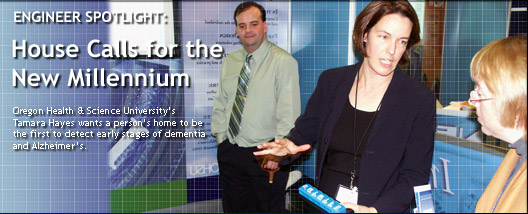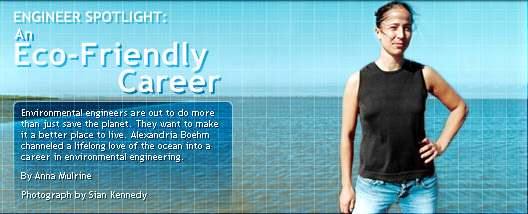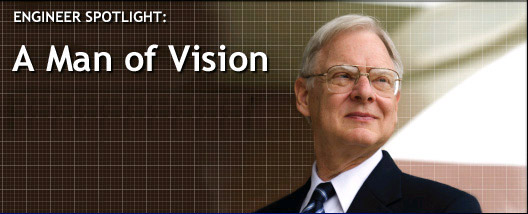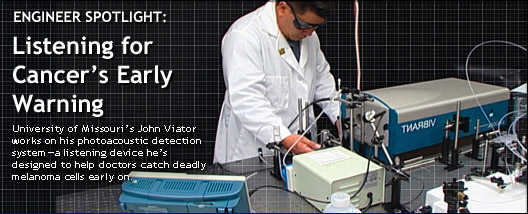Posted on June 28th, 2007 by als
 In the future, it may not be our family doctor, or our friends, or even our family who are the first to notice when our memory starts to slip. If Tamara Hayes’ research is any indication, the first warnings that our health is flagging will come from our houses.
In the future, it may not be our family doctor, or our friends, or even our family who are the first to notice when our memory starts to slip. If Tamara Hayes’ research is any indication, the first warnings that our health is flagging will come from our houses.
Read More
Filed under: Biomedical, Explore Engineering | Comments Off on Engineer Spotlight: Tamara Hayes
Posted on June 28th, 2007 by als
 Alexandria Boehm grew up in Oahu, Hawaii, immersed in the ocean. “I spent a lot of time in the water,” she recalls, “surfing, snorkeling, SCUBA diving.” But when Boehm started college, “I didn’t know I’d end up studying coastal waters,” she says. “It just sort of developed that way.”
Alexandria Boehm grew up in Oahu, Hawaii, immersed in the ocean. “I spent a lot of time in the water,” she recalls, “surfing, snorkeling, SCUBA diving.” But when Boehm started college, “I didn’t know I’d end up studying coastal waters,” she says. “It just sort of developed that way.”
Read More
Filed under: Environmental, Explore Engineering | Comments Off on Engineer Spotlight: Alexandria Boehm
Posted on June 27th, 2007 by als
 Like father, like son. That’s true of a number of engineers, and David Wormley, the dean of engineering at Penn State and the president of ASEE, is no exception. His father was a mechanical engineer and a factory manager for John Deere when David was growing up in Dubuque, Iowa.
Like father, like son. That’s true of a number of engineers, and David Wormley, the dean of engineering at Penn State and the president of ASEE, is no exception. His father was a mechanical engineer and a factory manager for John Deere when David was growing up in Dubuque, Iowa.
Read More
Filed under: Explore Engineering, Mechanical | Comments Off on Engineer Spotlight: David Wormley
Posted on June 27th, 2007 by als
 As a 13-year-old girl from Venezuela, Oksana Wall visited Disney World in Florida, and the Magic Kingdom immediately cast a spell on her. “I knew I wanted to work for Disney,” Wall says. “It was such a happy place.” Her father was an engineer, and she was good at math and science, so she was already leaning toward an engineering career. “But that trip made up my mind.”
As a 13-year-old girl from Venezuela, Oksana Wall visited Disney World in Florida, and the Magic Kingdom immediately cast a spell on her. “I knew I wanted to work for Disney,” Wall says. “It was such a happy place.” Her father was an engineer, and she was good at math and science, so she was already leaning toward an engineering career. “But that trip made up my mind.”
Read More
Filed under: Civil, Explore Engineering | 1 Comment »
Posted on June 27th, 2007 by als
 John Viator has an ear for skin cancer. Literally. Viator, a biomedical engineering professor at the University of Missouri, Columbia, fashioned the listening device out of a laser, special microphones and a computer interface. And while the setup doesn’t look much like an ear—Viator calls it a photoacoustic detection system—he thinks it can help doctors “listen in” on deadly melanoma cells as they spread throughout the bloodstream.
John Viator has an ear for skin cancer. Literally. Viator, a biomedical engineering professor at the University of Missouri, Columbia, fashioned the listening device out of a laser, special microphones and a computer interface. And while the setup doesn’t look much like an ear—Viator calls it a photoacoustic detection system—he thinks it can help doctors “listen in” on deadly melanoma cells as they spread throughout the bloodstream.
Read More
Filed under: Biomedical, Explore Engineering | Comments Off on Engineer Spotlight: John Viator
 In the future, it may not be our family doctor, or our friends, or even our family who are the first to notice when our memory starts to slip. If Tamara Hayes’ research is any indication, the first warnings that our health is flagging will come from our houses.
In the future, it may not be our family doctor, or our friends, or even our family who are the first to notice when our memory starts to slip. If Tamara Hayes’ research is any indication, the first warnings that our health is flagging will come from our houses.








 Alexandria Boehm grew up in Oahu, Hawaii, immersed in the ocean. “I spent a lot of time in the water,” she recalls, “surfing, snorkeling, SCUBA diving.” But when Boehm started college, “I didn’t know I’d end up studying coastal waters,” she says. “It just sort of developed that way.”
Alexandria Boehm grew up in Oahu, Hawaii, immersed in the ocean. “I spent a lot of time in the water,” she recalls, “surfing, snorkeling, SCUBA diving.” But when Boehm started college, “I didn’t know I’d end up studying coastal waters,” she says. “It just sort of developed that way.”  Like father, like son. That’s true of a number of engineers, and David Wormley, the dean of engineering at Penn State and the president of ASEE, is no exception. His father was a mechanical engineer and a factory manager for John Deere when David was growing up in Dubuque, Iowa.
Like father, like son. That’s true of a number of engineers, and David Wormley, the dean of engineering at Penn State and the president of ASEE, is no exception. His father was a mechanical engineer and a factory manager for John Deere when David was growing up in Dubuque, Iowa.  As a 13-year-old girl from Venezuela, Oksana Wall visited Disney World in Florida, and the Magic Kingdom immediately cast a spell on her. “I knew I wanted to work for Disney,” Wall says. “It was such a happy place.” Her father was an engineer, and she was good at math and science, so she was already leaning toward an engineering career. “But that trip made up my mind.”
As a 13-year-old girl from Venezuela, Oksana Wall visited Disney World in Florida, and the Magic Kingdom immediately cast a spell on her. “I knew I wanted to work for Disney,” Wall says. “It was such a happy place.” Her father was an engineer, and she was good at math and science, so she was already leaning toward an engineering career. “But that trip made up my mind.”  John Viator has an ear for skin cancer. Literally. Viator, a biomedical engineering professor at the University of Missouri, Columbia, fashioned the listening device out of a laser, special microphones and a computer interface. And while the setup doesn’t look much like an ear—Viator calls it a photoacoustic detection system—he thinks it can help doctors “listen in” on deadly melanoma cells as they spread throughout the bloodstream.
John Viator has an ear for skin cancer. Literally. Viator, a biomedical engineering professor at the University of Missouri, Columbia, fashioned the listening device out of a laser, special microphones and a computer interface. And while the setup doesn’t look much like an ear—Viator calls it a photoacoustic detection system—he thinks it can help doctors “listen in” on deadly melanoma cells as they spread throughout the bloodstream.